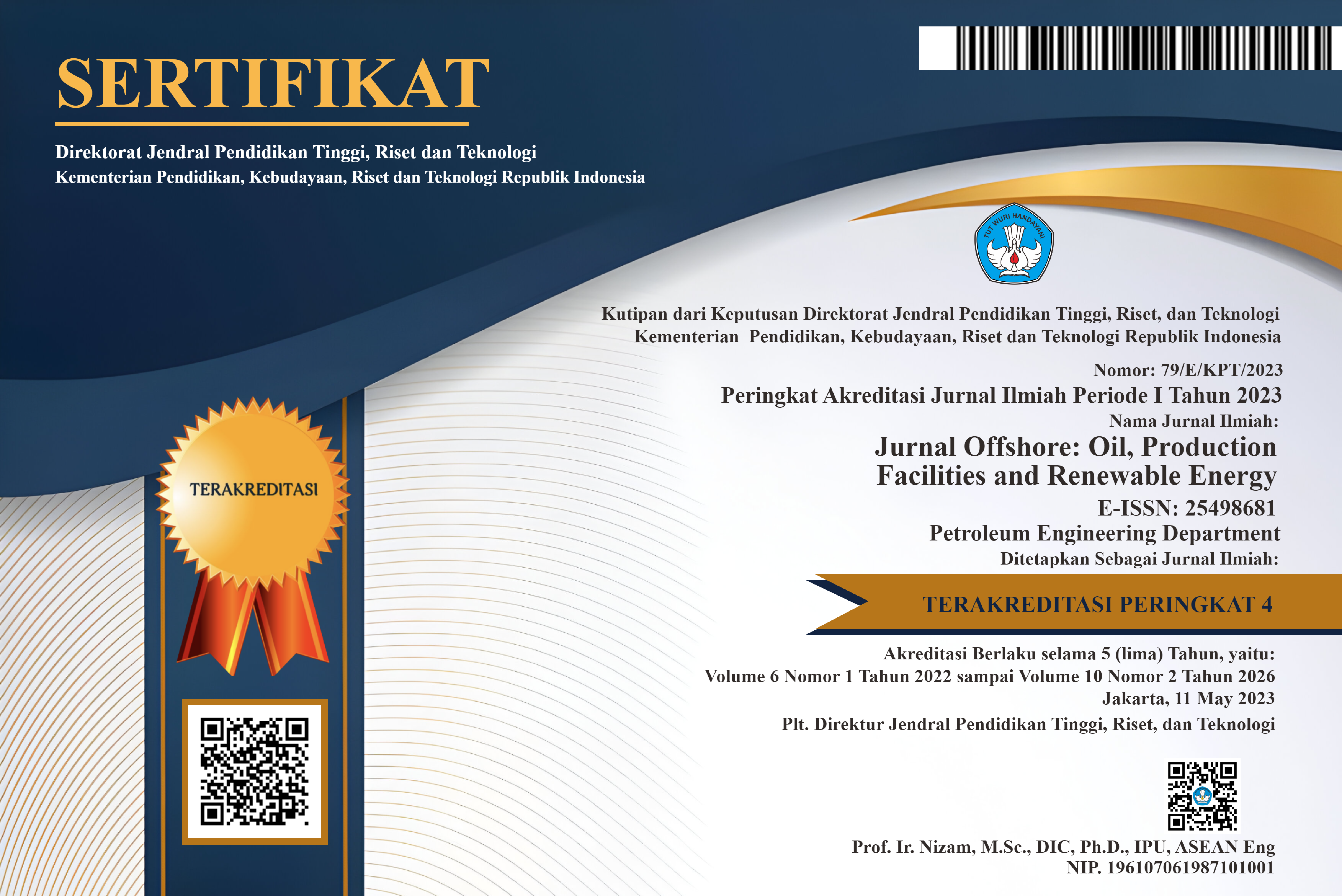PENGARUH MATERIAL RESINEX TERHADAP PROPERTIES HPHT FILTER PRESS PADA TEMPERATURE 200 ℉ LUMPUR KCL-POLYMER
DOI:
https://doi.org/10.30588/jo.v7i2.1718Abstract
Pada pemboran trayek 17 ½” ini menembus formasi Muara Enim – Talangakar yang memiliki litologi shale dengan temperatur tinggi, dimana hal tersebut dapat merubah sifat fisik Lumpur, material Additive Resinex pada Lumpur Pemboran berperan menjadikan lumpur pemboran lebih stabil pada temperature tinggi sekaligus sebagai fluid loss control agent. Tujuan Penelitian ini untuk mengetahui perubahan mud properties pada water base mud Kcl polymer dengan berbagai variasi konsentrasi Resinex yang sesuai dengan spesifikasi, selanjutnya untuk mendapatkan pemilihan konsetrasi Resinex yang terbaik yang sesuai pada trayek ini. Percobaan ini dilakukan skala Laboratorium dengan melakukan pengujian Lumpur Kcl polymer yang ditambahkan material Resinex sebanyak 2 gram, 4 gram, 6 gram, dan 8 gram. Hasil pengujian mud weight, pH, rheology, API filtrate, dan Clˉ. Hasil Penelitian didapatkan properties lumpur yang bervariasi, dimana hasil yang paling optimal dan ekonomis yaitu dengan penggunaan konsentrasi Resinex 6 gram.
References
Al-Hameedi, A. T. T., Alkinani, H. H., Dunn-Norman, S., Al-Alwani, M. A., Feliz, J. D., Alshammari, A. F., Albazzaz, H. W., Hamoud, Z. A., Mutar, R. A., & Al-Bazzaz, W. H. (2019). Laboratory study of environmentally friendly drilling fluid additives to be used a thinner in water-based muds. Society of Petroleum Engineers - Abu Dhabi International Petroleum Exhibition and Conference 2019, ADIP 2019. https://doi.org/10.2118/197846-ms
Al-Yami, A., Al-Jubran, M., Wagle, V., & Al-Mulhim, M. (2019). Development of a new reservoir-friendly drilling fluid for higher gas production. Society of Petroleum Engineers - Abu Dhabi International Petroleum Exhibition and Conference 2018, ADIPEC 2018, 1–10. https://doi.org/10.2118/192762-ms
Challenges for Drilling Fluids in Hpht. (2019). 6(6), 172–181.
Emanuella W.Y.P., E., Panca W, P., & Risna, R. (2022). Penelitian Desain Lumpur untuk Mengatasi Terjadinya Pengendapan oleh Material Lumpur maupun Formasi akibat Pengaruh Temperatur Tinggi dan Kontaminan Fluida Formasi. Lembaran Publikasi Minyak Dan Gas Bumi, 44(2), 171–184. https://doi.org/10.29017/lpmgb.44.2.162
Howard, S., Kaminski, L., & Downs, J. (2015). Xanthan stability in formate brines - Formulating non- damaging fluids for high temperature applications. SPE - European Formation Damage Conference, Proceedings, EFDC, 2015-Janua, 1388–1413. https://doi.org/10.2118/174228-ms
Ismail, A. R., Alias, A. H., Sulaiman, W. R. W., Jaafar, M. Z., & Ismail, I. (2017). Drilling fluid waste management in drilling for oil and gas wells. Chemical Engineering Transactions, 56, 1351–1356. https://doi.org/10.3303/CET1756226
Lapeyrouse, N. J. (2002). Calculations for Drilling, Production , Workover: all the formulas you need to solve drilling and prodution problems.
Rana, A., Saleh, T. A., & Arfaj, M. K. (2019). Improvement in rheological features, fluid loss and swelling inhibition of water-based drilling mud by using surfactant-modified graphene. Society of Petroleum Engineers - Abu Dhabi International Petroleum Exhibition and Conference 2019, ADIP 2019, 1–10. https://doi.org/10.2118/197774-ms
Awaliyah Nurhidayatika (2016). Penelitian sifat fisik lumpur air asin dengan aditif filtrasi pada suhu tinggi. FTKE USAKTI.
Mi-Swaco (2006) Product Specification Resinex- EH
Rubiandini, R. (2010). Hole Problem. Institut Teknologi Bandung-MPR, Drill-007, 1–26.
Downloads
Additional Files
Published
How to Cite
Issue
Section
License
Authors retain copyright and grant the Jurnal Offshore right of first publication with the work simultaneously licensed under a Creative Commons Attribution 4.0 International License that allows others to share (copy and redistribute the material in any medium or format) and adapt (remix, transform, and build upon the material) the work for any purpose, even commercially with an acknowledgement of the work's authorship and initial publication in Jurnal Offshore. Authors are able to enter into separate, additional contractual arrangements for the non-exclusive distribution of the journal's published version of the work (e.g., post it to an institutional repository or publish it in a book), with an acknowledgement of its initial publication in Jurnal Offshore. Authors are permitted and encouraged to post their work online (e.g., in institutional repositories or on their website) prior to and during the submission process, as it can lead to productive exchanges, as well as earlier and greater citation of published work (See The Effect of Open Access).















